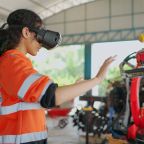Learners can experience virtual reality (VR) technology in several ways, including handheld controllers or newly developed haptic gloves. While handheld controllers for VR training are the more well-known option, haptic gloves are being quickly adopted to transform VR training through increased immersion.
VR controllers are handheld and allow learners to interact with their environment via thumbsticks, buttons, and touchpads. Alternatively, learners can experience a more immersive feel with haptic gloves that they wear on their hands.
When you think of virtual reality (VR), what do you picture? A headset and two controllers, right?
While this may be the traditional image that comes to mind, there are other ways to experience this technology. In particular, haptic gloves are a developing technology that are pushing the boundaries of VR immersion.
At Roundtable Learning, our team of technology experts stay up-to-date on the latest and greatest trends in the VR training space. Our experts are following the industry closely to figure out how exactly haptic gloves can be used for corporate training.
This article will compare and contrast virtual reality handheld controllers and haptic gloves by exploring their capabilities, limitations, and examples of each.
What Are Virtual Reality Handheld Controllers?
With a VR headset, learners see their virtual world. With VR controllers, learners interact with it. VR controllers come in many shapes and sizes depending on their manufacturer, including Oculus, VIVE, Pico, and more.
The quality of VR controllers can vary depending on the manufacturer and generally come with the following capabilities:
- Wireless tracking of hand movements
- Thumbsticks, buttons, and touchpads that allow for interactions with objects and people within the VR environment
- Typically come at no additional cost with the headset
Drawbacks Of Virtual Reality Handheld Controllers
- Limited interactions with virtual objects and people – Given that learners must hold their VR controllers in their hands and operate them, their interactions with objects and people within their VR environment are limited.
- Controls aren’t always intuitive – Learners may encounter issues when operating their controllers, from not knowing what button to press to confusion regarding their laser pointer.
What Are Haptic Gloves For Virtual Reality Training?
As technology in the VR space continues to advance, learners are experiencing their VR training in new, exciting ways. One of such advancements are haptic gloves. With a growing number of manufacturers (e.g. HaptX, Teslasuit, and SenseGlove), these gloves are certainly transforming how we learn.
Haptic gloves are wearable devices that allow users to experience realistic touch and interactions through advanced tactile feedback. Used in a VR environment, learners experience a realistic sense of touch due to haptic sensors and motors within the gloves.
The main capabilities of haptic gloves for virtual reality training include:
- Increased feeling of immersion by adding depth to physical interactions
- Increases sensory feedback that reinforces muscle memory
- Decreases the transition time between training and practice, leading to increased safety and productivity
Drawbacks Of Haptic Gloves for Virtual Reality Training
- May be tethered – While different vendors use varying technologies for their haptic gloves, some may require a connection to power the gloves (e.g. an air compressor).
- May be heavy and awkward to use – For some learners, haptic gloves may feel heavy and be bulky to use, distracting them as they try to learn.
- Come at an additional cost – Since haptic gloves are not part of a traditional VR hardware set, it will be an additional investment for organizations.
Examples Of Virtual Reality Training With Handheld Controllers vs. Haptic Gloves
Example Of Virtual Reality Training With Handheld Controllers
To use handheld controllers, learners must put on and tighten their controller’s strap, hold one controller in each hand, and use buttons to interact with objects. To complete interactions, learners use their controllers to hover over an object, then press their trigger.
Throughout this activity, learners are placed in a warehouse environment where they use their handheld VR controllers to practice packaging processes. Learners use the buttons, thumbsticks, and touchpads on each of their VR remotes to complete tasks from grabbing packaging labels to building their pallet.
Read More: Top 5 VR Headset Alternatives To The Oculus Quest For 2021
Example Of Virtual Reality Training With Haptic Gloves
To use haptic gloves, learners put them on and secure them. Once the gloves are fitted to a learner’s hands, they can use their fingers to press buttons and move objects as they would in real life. To pick up objects, learners simply reach out for it and grab it with their hands or fingers.
Throughout this activity, haptic gloves allow learners to experience real-life sensations of working in this manufacturing environment. Learners are able to point their index finger and touch buttons on the screen in front of them, as well as pick up boxes in front of them. As they grab the box, tactile actuators within the gloves replicate the real-life sensation of picking up the box, causing the learners to feel resistance when contact is made with the box.
What Type Of Virtual Reality Experience Will Your Learners Complete?
This article has covered two options for completing interactions within a VR training environment: handheld controllers and haptic gloves. We hope that by reading this article, you’ve become more aware of the capabilities and limitations of each.
Wondering if VR is the right fit for your organization’s training needs? An expert on our team is here to help! Reach out to one of our learning professionals or check out more of our resources on all things L&D.








